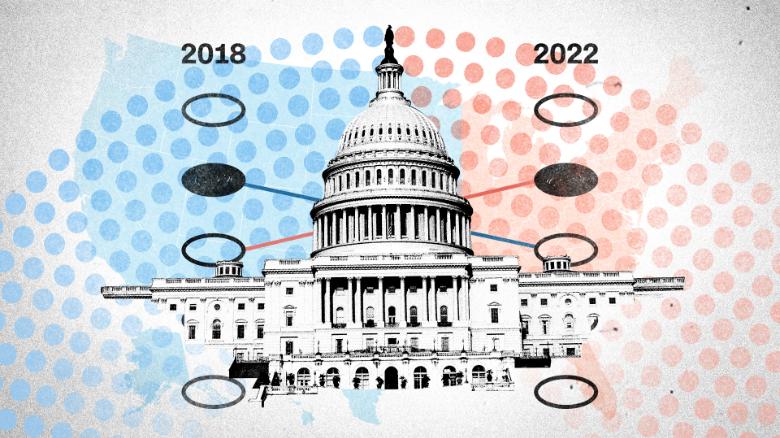
Four years after rebuking a Republican president and giving control of the House of Representatives to Democrats in 2018, US voters did not deliver the red wave some Republicans had predicted and which Democrats had feared. As of early Wednesday morning, CNN had not projected which party would lead either the House or the Senate.
This is a look at two very different midterm elections and who showed up for a blue wave in 2018, when Democrats picked up a net of 40 seats, and whats shaping up to be a relatively close election in 2022. Its important to note theres a lot of variation across the country.
Below is a breakdown of some preliminary results of CNNs exit poll of pre-election and Election Day voters, showing how different groups voted in the race for Congress this year, compared with the midterm election four years ago.
CNNs 2022 exit polls include interviews with thousands of voters, both those who cast a ballot on Election Day and those who voted early or absentee. That scope makes them a powerful tool for understanding the demographic profile and political views of voters in this year's election. And their findings will eventually be weighted against the ultimate benchmark: the results of the elections themselves. Even so, exit polls are still polls, with margins for error which means they're most useful when treated as estimates, rather than precise measurements. That's particularly true for the earliest exit poll numbers, which haven't yet been adjusted to match final election results.
CNN Exit Polls are a combination of in-person interviews with Election Day voters and in-person interviews, telephone and online polls measuring the views of early and absentee by-mail voters. They were conducted by Edison Research on behalf of the National Election Pool. In-person interviews on Election Day were conducted at a random sample of 250 polling locations. The results also include interviews with early and absentee voters conducted in person at 72 early voting locations, by phone or online. Results for the full sample of 15,234 respondents have a margin of error of plus or minus 2 percentage points; it is larger for subgroups.
Exit poll data for 2022 will continue to update and will automatically reflect in the charts below.
By gender
Democrats lost support among women in 2022 compared with 2018.
When Democrats took control of the House after the 2018 election, a little more than half of voters were women and the party had a huge advantage among them. Even though women represented a similar majority of voters in 2022, Democrats lead appears to be cut noticeably. Additionally, in 2022, Republicans grew their support among men.
Early exit polls confirmed that Americans do support abortion rights. Only a little more than a third of voters said abortion should be illegal in all or most cases. But while Republicans in the House won the support of nearly all of the voters who oppose abortion rights, they also got the support of a quarter of the voters who said it should be legal.
By age
Democrats lost support among younger voters in 2022 compared with 2018. Republicans won older voters.
Young voters have traditionally supported Democrats and winning them by huge margins helped the party in 2018. Republicans have eaten into that advantage this year.
Democrats and Republicans split older voters in 2018, but Republicans won majority support in 2022.
By race/ethnicity and gender
Republicans won over White women and Democrats lost support among Latino voters.
Republicans won a majority of White women, an important voting bloc the two parties split in 2018. Republicans also made good on predictions that they would perform better among Latino voters than they did four years ago. Democrats support among Latino men was 63% in 2018 and is under 55% in 2022, according to the early exit polls. Republicans appeared to cut into Democrats advantage among Latino women, although Democrats still got the support of about two-thirds of them.
The urban-rural divide
Suburban voters shifted toward Republicans.
Most American voters lived in the suburbs in both 2018 and 2022. But while suburban voters were evenly split when Democrats took control of the House four years ago, they moved toward Republicans in 2022. An already-strong Republican lead among rural voters got even bigger and Republicans even ate into Democrats lead in urban areas.
By view on the economy
Some shift was to be expected.
With a Republican president in 2018, more Republicans said the economy was in good condition. In 2022, with a Democratic president, Democrats are likely to see it as better. Overall, more than two-thirds of all voters said the economy was excellent or good in 2018 and in 2022, its just a quarter of voters.
By race and education
Republicans gained among White voters without a college degree.
Democrats lost some support among voters of color, and Republicans consolidated their support among White voters without a college degree.
By ideology
Fewer moderates supported Democrats.
Democrats saw their support among moderates somewhat erode. Republicans built on their support among conservatives.
By the party that voters identify with (regardless of which House candidate they voted for this year)
More Republicans showed up. Democrats lost some independents.
Back in 2018, 37% of voters said they were Democrats, compared with 33% who said they were Republicans and 30% who said they were independents. In 2022, it was Republicans who have the edge. When they won control of the House in 2018, Democrats had an advantage among independent voters. That is nearly gone in 2022.
By view on parties
Republicans won over those who like neither party.
Both Democrats and Republicans improved their performance among the party faithful. But Republicans built a lead among voters who dont have a a favorable view of either party. Democrats lost their edge among voters who have a favorable view of both parties.











